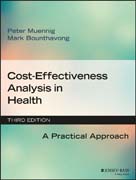
Cost-Effectiveness Analysis in Health: A Practical Approach
Muennig, Peter
Bounthavong, Mark
The field?s bestselling reference, updated with the latest tools, data, and techniques Cost–Effectiveness Analysis in Health is a practical introduction to the tools, methods, and procedures used worldwide to perform cost–effective research. Covering every aspect of a complete cost–effectiveness analysis, this book shows you how to find which data you need, where to find it, how to analyze it, and how to prepare a high–quality report for publication. Designed for the classroom or the individual learner, the material is presented in simple and accessible language for those who lack a biostatistics or epidemiology background, and each chapter includes real–world examples and tips and tricks that highlight key information. Exercises throughout allow you to test your understanding with practical application, and the companion website features downloadable data sets for students, as well as lecture slides and a test bank for instructors. This new third edition contains new discussion on meta–analysis and advanced modeling techniques, a long worked example using visual modeling software TreeAge Pro, and updated recommendations from the U.S. Public Health Service?s Panel on Cost–Effectiveness in Health and Medicine. Cost–effectiveness analysis is used to evaluate medical interventions worldwide, in both developed and developing countries. This book provides process–specific instruction in a concise, structured format to give you a robust working knowledge of common methods and techniques. Develop a thoroughly fleshed–out research project Work accurately with costs, probabilities, and models Calculate life expectancy and quality–adjusted life years Prepare your study and your data for publication Comprehensive analysis skills are essential for students seeking careers in public health, medicine, biomedical research, health economics, health policy, and more. Cost–Effectiveness Analysis in Health walks you through the process from a real–world perspective to help you build a skillset that?s immediately applicable in the field. INDICE: List of Tables, Figures, and Exhibits .Preface .Acknowledgments .About the Author .Chapter 1: Introduction to Cost–Effectiveness .Learning Objectives .Overview .Why Cost–Effectiveness Is Useful .Elements of Cost–Effectiveness Analysis .The Average and Incremental Cost–Effectiveness Ratio .Why Conduct Cost–Effectiveness Analysis? .The Reference Case Analysis .Cost–Effectiveness Analysis and Policy .Summary .Further Readings .References .Chapter 2: Principles of Cost–Effectiveness Analysis .Learning Objectives .Overview .The Perspective of a Cost–Effectiveness Analysis .Capturing Costs .Capturing Quality .Interpreting the Cost–Effectiveness Ratio .Types of Economic Analysis .Summary .Further Readings .References .Chapter 3: Developing a Research Project .Learning Objectives .Overview .Eight Steps to a Perfect Research Project .Developing a Research Question .Designing Your Analysis .Summary .Further Readings .References .Chapter 4: Working with Costs .Learning Objectives .Overview .Opportunity Costs .Identifying Costs .Micro–Costing and Gross Costing .Getting Cost Data .Using Diagnosis Codes .Adjusting Costs .Costs Associated with Pain and Suffering .Assessing the Relevancy of Cost Data .Other Cost Considerations .Summary .Further Readings .References .Chapter 5: Probabilities and Decision Analysis Models .Learning Objectives .Overview .The Idea Behind Decision Analysis .Probabilities .Decision Analysis Models .Summary .Further Reading .References .Chapter 6: Calculating Life Expectancy .Learning Objectives .Overview .Hand–Calculating Years Gained .Calculating Life–Years Lost Using Markov Models .Summary .Further Readings .References .Chapter 7: Working with Health–Related Quality–of–Life Measures .Learning Objectives .Overview .Framework .Deriving HRQL Scores .Other Considerations and Reminders .Using Disability–Adjusted Life–Years .Summary .Further Readings .References .Chapter 8: Calculating QALYs .Learning Objectives .Overview .Using the Summation Method .Using the Life Table Method .More On Discounting .Issues with QALYs .Calculating Incremental Cost–Effectiveness .Disability–Adjusted Life–Year (DALY) .Summary .Further Readings .References .Chapter 9: Conducting a Sensitivity Analysis .Learning Objectives .Overview .Performing a Sensitivity Analysis .One–Way Sensitivity Analysis .Two–Way Sensitivity Analysis .Tornado Diagram .Multiway Sensitivity Analysis .Summary .Further Readings .References .Chapter 10: Preparing Your Study for Publication .Learning Objectives .Overview .Content and Structure of Cost–Effectiveness Articles .Title and Abstract .Introduction .Methods .Results .Discussion .Other .Technical Appendix .Figures and Illustrations .Summary .Further Reading .References .Chapter 11: Basic Concepts in Epidemiology and Application to Cost–Effectiveness Analysis .Learning Objectives .Overview .Review of Incidence .Understanding Error .Managing Error in Cost–Effectiveness Analysis .Calculating Weighted Means .Evaluating Study Limitations .Summary .Further Readings .References .Chapter 12: Finding the Data You Need .Learning Objectives .Overview .Finding Data in the Medical Literature .Grading Published Data .Using Electronic Datasets .Data Extraction Tools .Using Unpublished Data .Using Expert Opinion .Organizing Your Data .Summary .Further Readings .References .Chapter 13: A Worked Example .Learning Objectives .Overview .Helping Students Learn .Laboratory Exercise One: Building a Markov Tree .Laboratory Exercise Two: Comparing Interventions .Laboratory Exercise Three: The Cost–Effectiveness of Health Insurance .Laboratory Exercise Four: Sensitivity Analysis .Summary .Appendix A: Answer Key to Exercises .Appendix B: Life Expectancy and Quality–Adjusted Life Expectancy Tables .Appendix C: EQ–5D–5L Health Questionnaire (English Version for the United States) .Appendix D: Diagnosis, Charges, Medicare Reimbursement, Average Length of Stay, and Cost–to–Charge Ratio by Diagnosis–Related Groups, 2011 .Glossary .Index
- ISBN: 978-1-119-01126-2
- Editorial: John Wiley & Sons
- Encuadernacion: Rústica
- Páginas: 340
- Fecha Publicación: 23/03/2016
- Nº Volúmenes: 1
- Idioma: Inglés
